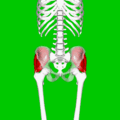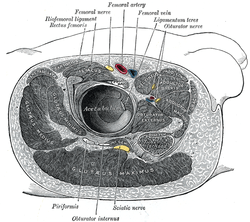Gluteus medius muscle
| Gluteus medius | |
|---|---|
 Position of gluteus medius muscle (shown in red). Posterior view. | |
|
The gluteus medius and nearby muscles. | |
| Details | |
| Origin | Gluteal surface of ilium, under gluteus maximus |
| Insertion | Greater trochanter of the femur |
| Artery | superior gluteal artery |
| Nerve | superior gluteal nerve (L4, L5, S1 nerve roots) |
| Actions | abduction of the hip; preventing adduction of the hip. Medial rotation of thigh. |
| Antagonist | adductors |
| Identifiers | |
| Latin | musculus glutaeus medius |
| TA | A04.7.02.007 |
| FMA | 22315 |
The gluteus medius (or glutæus medius), one of the three gluteal muscles, is a broad, thick, radiating muscle, situated on the outer surface of the pelvis.
Its posterior third is covered by the gluteus maximus, its anterior two-thirds by the gluteal aponeurosis, which separates it from the superficial fascia and integument.
Structure
The gluteus medius muscle starts, or "originates," on the outer surface of the ilium between the iliac crest and the posterior gluteal line above, and the anterior gluteal line below; the gluteus medius also originates from the gluteal aponeurosis that covers its outer surface.
The fibers of the muscle converge into a strong flattened tendon that inserts on the lateral surface of the greater trochanter. More specifically, the muscle's tendon inserts into an oblique ridge that runs downward and forward on the lateral surface of the greater trochanter.
Relations
A bursa separates the tendon of the muscle from the surface of the trochanter over which it glides.
Variations
The posterior border may be more or less closely united to the piriformis, or some of the fibers end on its tendon.
The posterior fibres of gluteus medius contract to produce hip extension, lateral rotation and abduction. During gait, the posterior fibres help to decelerate internal rotation of the femur at the end of swing phase.
Function
With the leg in neutral position (straightened), the gluteus medius and gluteus minimus function together to pull the thigh away from midline, or "abduct" the thigh. During gait, these two muscles function principally in supporting the body on one leg, in conjunction with the tensor fasciae latae, to prevent the pelvis from dropping to the opposite side.
Additionally, with the hip flexed, the gluteus medius and minimus internally rotate the thigh. With the hip extended, the gluteus medius and gluteus minimus externally rotate the thigh.[1][2] This external rotation force does not actually draw the hip outwards, rather it acts to prevent internal rotation. Without this action, or in the presence of pathology, the knee would migrate inwards (genu valgum), creating stress on the structures at the hip, knee and foot.
Clinical significance
Dysfunction of the gluteus medius or the superior gluteal nerve can potentially be indicated by a positive Trendelenburg's sign.
Additional images
 Position of gluteus medius muscle (shown in red). Hip bone is shown in semi-transparent.
Position of gluteus medius muscle (shown in red). Hip bone is shown in semi-transparent. Structures surrounding right hip-joint.
Structures surrounding right hip-joint.- Gluteus medius muscle (shown in green text)
See also
References
This article incorporates text in the public domain from the 20th edition of Gray's Anatomy (1918)
- ↑ "Variation of rotation moment arms with hip Flexion", Delp et al, Journal of Biomechanics, 1999
- ↑ Pratt, N. Clinical Musculoskeletal Anatomy. CBLS: Marietta, OH 2004.
External links
| Wikimedia Commons has media related to Gluteus medius muscles. |
- -200933297 at GPnotebook
- Anatomy photo:13:st-0404 at the SUNY Downstate Medical Center
- Cross section image: pelvis/pelvis-e12-15 - Plastination Laboratory at the Medical University of Vienna